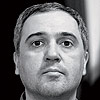 |
For a few months surrounding the election, Carol Felsenthal, a biographer and Chicago contributing editor, delved into Michelle Obama’s life and history for The Making of a First Lady. “Michelle is a hugely organized and energetic and goal-driven person,” Felsenthal says. Qualities such as these turn out to be the perfect complements for her husband. “The image that I’ve heard more than once is of Michelle standing on the ground, and [Barack]’s the kite,” Felsenthal says. “She’s holding the string trying to reel him in.” Felsenthal’s book on Bill Clinton’s post-presidency, Clinton in Exile, comes out in paperback in May.
 |
The names to know from Chicago’s filmmaking business appear in the 27 mini profiles in Action Heroes, by Robert Loerzel (left) and Jeff Ruby. The subjects range from Richard Moskal, the head of the Chicago Film Office (“His life is one big logistical nightmare after another,” Ruby says), to Harold Ramis, a Glencoe resident and Chicago-history enthusiast. “[Ramis] started talking about how much he loves Clarence Darrow and Emma Goldman,” Loerzel says. “The first movie script he wrote, which never got made, was about the Haymarket Riot.” Loerzel is working on a book about Chicago in the early 1900s, tentatively titled The Nearest Place to Hell.
Shane Tritsch saw the megablockbuster The Dark Knight last summer, and he kept finding his eyes drawn to the background, to all the Chicago landmarks. “I like to think of myself as this jaded and worldly sophisticate,” Tritsch says, but he couldn’t help but swell with pride at how cool the city looked. In writing Knight Moves, Tritsch, Chicago’s managing editor, examined Dark Knight’s location shooting and its governmental support, including tax incentives the state offers filmmakers. “What I learned to question was whether this really is a smart allocation of our tax dollars,” he says.
For Action Heroes, the New York–based artist Michael Camarra created several illustrations in his distinct collagelike style, which has the competitive advantage of flexibility. “If you don’t like any one element, you can add more into it and easily swap something out,” he says. “You can bring it to the computer and just play around with it. It’s close to design.” His work has appeared in My Midwest magazine and Phoenix magazine.
 |
Despite Our Town’s reputation as a high-school chestnut, Mara Tapp, a veteran arts writer, didn’t see the play until 2003. Now, with two must-see Our Town productions here in two years, she investigated for “Talk of Our Town” (in Theatre this month) why hot young directors would take on such a warhorse. “What I discovered was that it actually had gotten a bum rap,” she says. “It was a very radical piece.” It may be staged frequently, but it appeals across generational lines and lends itself to reinvention, she says, “in the league of the great Greek myths or a Shakespeare play.”
Photography: (Felsenthal) Anna Knott


